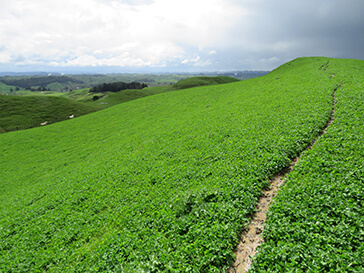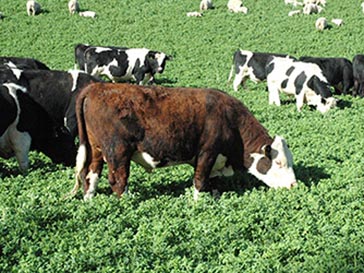Helicropping is a process-driven application of recently available technologies that enable helicopters to be used for the precision application of herbicides, fertiliser and seed on farm to establish crops and renew pastures. Led by a farmer interest, we want to ensure the process is environmentally sustainable, protecting our soils and water quality. We see knowledge gaps at the crop grazing phase and wish to evaluate mitigations including sediment buffers and bunds, and the role/establishment of cover and catch crops. This work aims to influence the way forage crops and new pastures are established so that there is less cultivation undertaken and the soil structure is left intact.
Key factors when considering sustainable helicropping include:
- Suitability of forage crop for helicropping to animal type (and age)
- Summer or winter crop? Recognition of good practice and implications of risk at grazing
- Managing risk - suitable mitigations?
- Post-grazing - cover/catch cropping to protect the soil
- Outcome of Helicropping - Improved pasture
Project Outcomes
Short-term outcomes
Information obtained from this project will be shared with the wider pastoral farming community, and will combine farmer experience, Farmax model outputs and data from field measurements in such a way that farmers nationwide will be able to:
- Confidently establish a range of both winter and summer crops using helicropping
- Create a feed-bank that can be break-fed off in late summer (summer crop) or early spring (winter crop)
- Confidently utilise that crop understanding that the impacts on soil loss and water contamination is mitigated
- Utilise the cropping process to eliminate problem weeds prior to establishing new pasture
- Re-grass pasture with modern high fertility pasture species
The objective is to ensure that helicropping is undertaken in suitable environments and utilised in a way that minimises environmental risks.
Longer-term outcomes
- More profitable and resilient farms (sheep and beef, dairy grazing)
- Retention of soils through maintained soil structure, improved soil cover (crop, pasture, cover and catch crops) and reducing grazing pressure on pastures.
- Reduction in cultivation (which has significant environmental risks including soil erosion and nutrient losses)
- Robust and relevant recommendations that are adoptable into a range of farming systems through multiple channels eg video clips, scientific publications and fact sheets
Maungahau Farm Case Study
Geoff and his wife Joanna Fitzgerald are the owners of Maungahau Farm. Geoff is a member of the ‘Sustainable Helicropping Group’ and has been using Helicropping to grow forage crops and renew pastures for the last 5 years.
In partnership with:


To find out more information about Helicropping or our Sustainable Farming Fund please get in touch via email. Click here to email us

Our Sustainable Helicropping team are committed to improving the process of helicropping on farm. To find out more about the research that is being done in this space check out the resources below. Helicropping – early adopters’ experiences. Hill country cropping with no land-based equipment